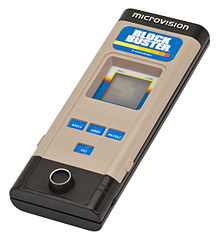
Microvision

Released in 1979 by Milton Bradley, the Microvision was the first handheld gaming console with interchangeable cartridges, a groundbreaking concept that paved the way for future portables like the Game Boy. However, despite its innovation, the system was plagued by hardware limitations and a short lifespan.
The Microvision featured a small monochrome LCD screen, a built-in membrane keypad, and a removable faceplate that doubled as the game cartridge. Each game came with its own control layout, meaning the buttons and interface changed depending on the title. While innovative, the screen was tiny and prone to damage, often suffering from screen rot or dead pixels. The console was also bulky and required a lot of battery power for limited playtime.
With only 12 officially released games, the Microvision had a limited but varied lineup, including:
Most of the games were basic arcade-style experiences, but they showed what was possible on a portable console at the time.
While the Microvision was revolutionary, it was also technically fragile-the LCD screen was unreliable, and the system was prone to overheating. These issues, along with a lack of developer support, led to its discontinuation in 1981.
Despite its short lifespan, the Microvision was a pioneer in handheld gaming. Its concept of swappable cartridges on a portable device laid the foundation for Nintendo's Game & Watch and, later, the Game Boy.
⭐ 6.5/10 - The Microvision was ahead of its time, but its fragile hardware and limited game selection kept it from true success. However, its impact on handheld gaming history is undeniable, making it a must-have for collectors and gaming historians.
Would you like a comparison with other early handhelds like the Game & Watch or Atari Lynx?
| Andy Stout stoutat@southwind.net on Friday, May 4, 2001 at 20:13:31 --------------------------------------------------------------------------- I just purchased a WORKING Microsystem in MINT condition at a garage sale with 8 games all in the original box with instructions for 5 bucks! I was wondering if these are worth anything... let me know! Thanks, Andy Stout
|
| Knuckles knuckles@home.com on Thursday, August 31, 2000 at 15:20:48 --------------------------------------------------------------------------- This was a neat little system that allowed you to play some simple liquid crystal games. each cartridge (if you can call them as such essential replaced the front face of the unit and put an overlay on top of the small LCD screen. For example, the overlay for Connect Four allowed the small black squares to become circles (ingenious hehe) With that in mind, one of the best and most addictive being Connect Four. Released in Canada by Milton Bradley it sold very poorly. I managed to pick mine up at a garage sale for $5 with about 10 games. I can't remember all of the titles but there was some simple Star Trek game that leaps to mind. "Microvision was introduced by Milton Bradley in 1979. Designed by Jay Smith (who later designed Vectrex), Microvision combined the cartridge interchangeability that was propelling Fairchild and Atari into the forefront with the portability that had helped Coleco and Mattel sell millions of handheld games. While the idea was fine (witness the success of Gameboy and Game Gear), the timing and support were not. After some initial success (grossing $8 million in its first year of production, and boosting Smith Engineering into a million-dollar operation), and an initial release of seven cartridges (including BlockBuster, which came with the unit), Milton Bradley rolled out just two new cartridges in 1980, and a final two in 1981. With a small library, no tie into a home unit, and a screen resolution that provided little ability to produce meaningful graphics, Microvision soon became little more than a memory. Still, the Microvision was a pioneer, overcoming the limitations of the light-emitting-diode displays that were standard for hand-held games at the time. For all the limitations of the unit, many of the games produced were quite good." |